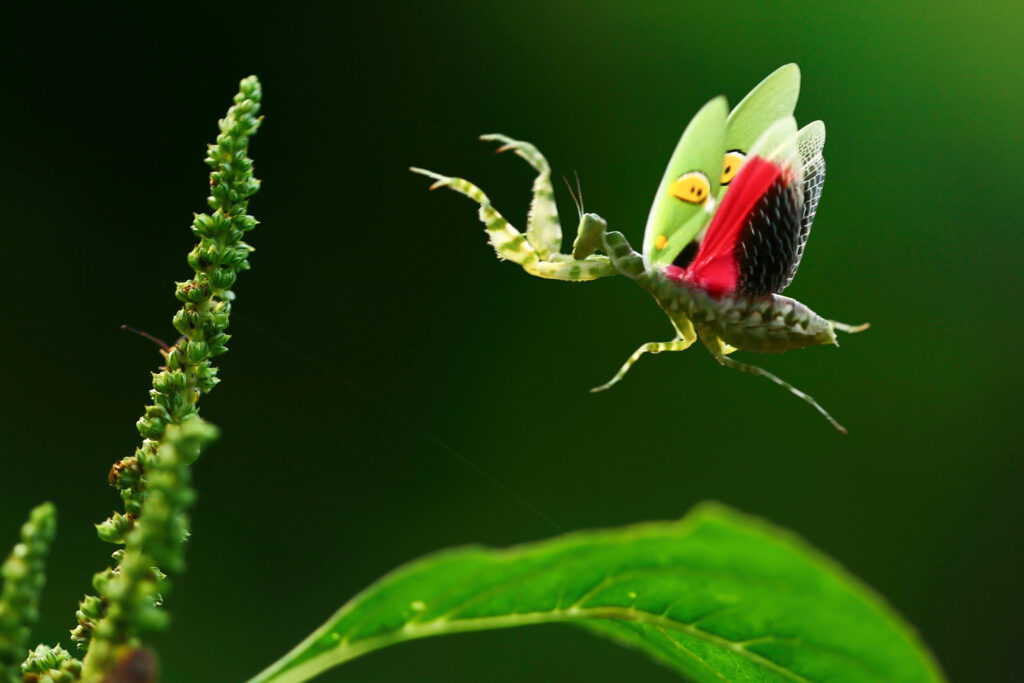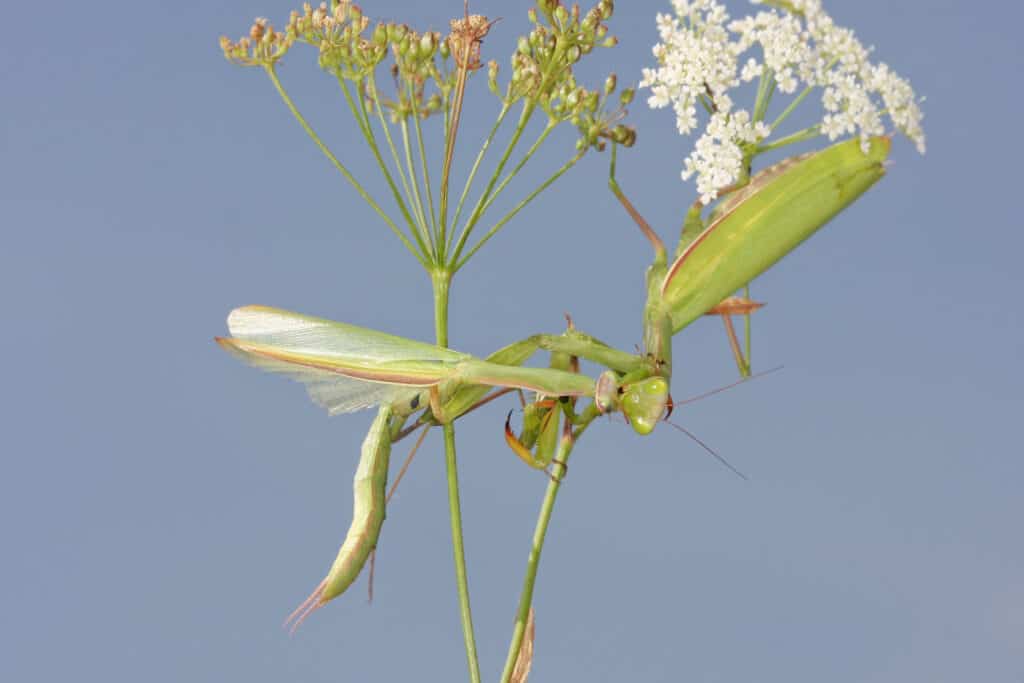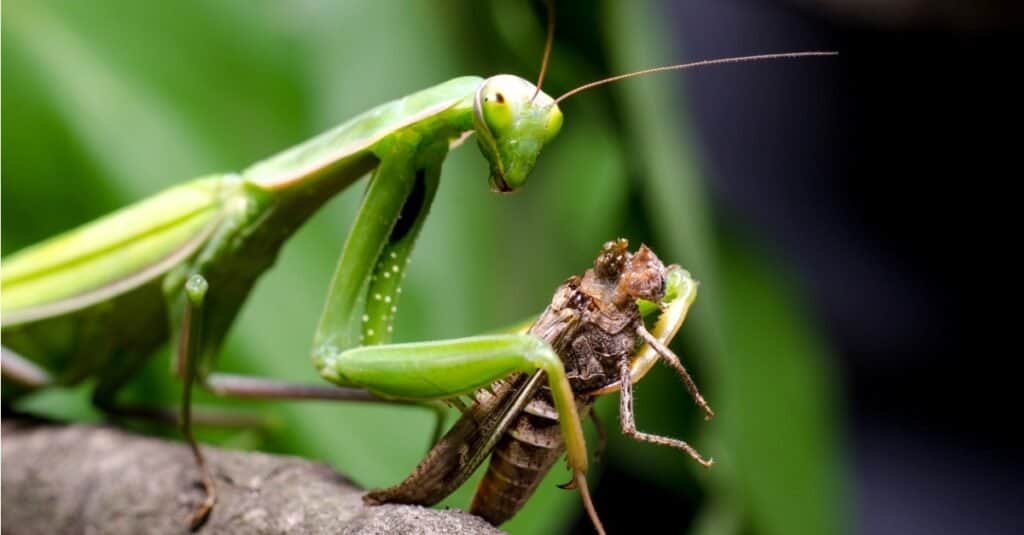Praying mantises are unique insects known for their bulbous eyes, triangular heads, and folded forelegs. However, the praying mantis is not a single species. The variety in the various species’ anatomy has made some people wonder, can praying mantises fly? Discover whether a praying mantis is capable of taking flight and why that question is so difficult to answer.
Why Asking if Praying Mantis Can Fly is Tricky

Praying mantises come in many shapes and sizes across thousands of species.
©SemilirBanyu/Shutterstock.com
The difficulty with asking if a praying mantis can fly is that the term doesn’t apply to a single species with very similar anatomy. It’s not like asking if a grizzly bear can climb trees. Instead, over 2,400 species of praying mantises exist throughout the world.
Some of them only measure a few inches long, while others can reach upwards of 5 inches long and grow so powerful that they can prey on birds. Not only do the latter species have the power needed to hunt hummingbirds, but they have the speed to strike the small, fast critters.
Generally, it’s simpler to categorize praying mantises in four different ways. That includes species that are:
- Wingless
- Possessing vestigial wings
- Having short wings
- Having long, fully developed wings
For the most part, the first three types of mantises can’t fly. They may or may not have wings depending on many factors like species, sex, and where they’re at in their life cycle. Praying mantises that are wingless or only have vestigial wings can’t fly. Furthermore, mantises with short wings cannot take to the skies. The praying mantises with long wings can potentially fly depending on other factors.
As you can see, several factors determine if a mantis can fly, clouding the question. Let’s take a look at what mantises are most likely to fly.
Do Praying Mantises Fly?

Some praying mantises can fly, but many cannot.
©SemilirBanyu/Shutterstock.com
Yes, some praying mantises can fly, but not all of them can fly. Praying mantises can only fly if they have the proper characteristics that allow them to take flight. Consider some of the qualities that allow them to fly or make them more likely to fly.
Anatomy
Some species of praying mantises have wings, but others do not. With over 2,400 or more species of praying mantises in the world, some develop wings and others do not. While several species are entirely wingless, others have vestigial wings that are useless for flying.
Only species with long wings are capable of taking flight. Yet, even then, not every member of the species will grow wings. That leads us to the next point.
Sex
Even if a species is capable of growing wings that are capable of flight, the sex of the flying mantis can impact whether or not it can fly. In many species, only the males grow wings capable of flight while the females stay wingless.
In some species where both the males and females grow wings, like the European Mantis, the males are capable of true flight. Meanwhile, the females can either fly for very short distances or cannot fly at all. Praying mantises exhibit sexual dimorphism where the females are bigger and heavier than the males. As a result, female praying mantises are often too large and heavy to achieve flight with their wings.
So, males are more likely to fly than females. That doesn’t mean all female praying mantises can’t fly, though.
Life Cycle or Molt Stage
Even if a praying mantis species can fly, they don’t hatch with the ability to fly. Instead, they need to undergo several molts to reach their adult stage. Typically, the final stage occurs after 5 or more molts, upwards of 10. This is highly dependent on many factors, including the species of the praying mantis.
All of these factors can affect the insects’ ability to fly. So, can a praying mantis fly? Yes, as long as it meets several criteria.
How Well Do Praying Mantises Fly?

Praying mantises don’t fly for very long distances.
©Geza Farkas/Shutterstock.com
Another thing to consider is how well praying mantises can fly. For the most part, female praying mantises that can fly do not fly very well. They take short flights to reach areas that they cannot otherwise reach. They’re also more likely to save their energy to lie in wait while waiting for prey to come close enough to strike.
Male praying mantises are lighter and thinner than females, so they can fly. However, they don’t fly exceptionally well over long distances. Still, they can cover modest distances by using their wings. They may also use a combination of jumping, gliding, and flying to reach their desired destination.
Why Do Praying Mantises Fly?

Praying mantises may fly to find prey or to escape becoming prey for another creature!
©iStock.com/artas
Can praying mantises fly? Yes, some of them can. An equally important question to ask is, how do they use their flying abilities? One of the foremost reasons that praying mantises can fly is to help them avoid predators. Praying mantises are hunted by many creatures like birds, frogs, hornets, and wasps. Having the ability to fly increases their chances of dodging these predators.
Of course, male praying mantises are also victims of sexual cannibalism. Following the act, they can use their flying abilities to escape becoming the female’s meal as fast as possible.
Also, male praying mantises may have developed or retained flight capabilities at a greater rate than females for reproductive opportunities. Male praying mantises will often use their flight abilities to follow the pheromones released by female praying mantises.
Male praying mantises will also use their wings and flying abilities to find food of their own. Praying mantises consume a variety of foods like insects, spiders, small amphibians, and even small birds.
Overall, the praying mantis can fly. Yet, not all species and genders can fly. Only some species with the right combination of body weight, wing development, and gender take to the skies. Even when they do, their flights are hardly graceful.
The photo featured at the top of this post is © Karel Bartik/Shutterstock.com
Thank you for reading! Have some feedback for us? Contact the AZ Animals editorial team.






